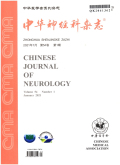SCN4A 基因 Thr704Met 突变致严重的家族性低钾性周期性麻痹
Mutation (Thr704Met) of the SCN4A gene causes severe familial hypokalemic periodic paralysis
摘要目的:探讨家族性低钾性周期性麻痹( hypokalemic periodic paralysis,HOKPP)一家系的致病基因及临床特征。方法对一HOKPP家系成员应用PCR扩增、DNA测序等方法筛查HOKPP相关候选基因(骨骼肌L型电压门控钙通道α1亚单位基因、电压门控钠离子通道编码基因、电压门控钾离子通道编码基因),研究致病基因与表型特征的相关性。结果先证者SCN4A基因13号外显子出现c.2111C>T突变,导致编码氨基酸改变(Thr704Met)。该家系所有受累个体均检测到该突变,而表型正常者未检测到该突变。该家系呈常染色体显性遗传,以反复发作性肌肉无力、疼痛、血钾减低为主要表现;起病早,病程长,发作频繁,寒冷为主要诱发因素;随着病程进展患者逐渐出现四肢近端持续性无力伴明显肌肉萎缩。结论 SCN4A基因Thr704Met突变为该家系的致病突变。该突变导致严重的HOKPP和进行性肌肉萎缩。
更多相关知识
abstractsObjective To investigate the clinical features and pathogenic genes of a familial hypokalemic periodic paralysis ( HOKPP).Methods PCR amplification and DNA sequencing were used to screen candidate genes of the HOKPP family members (CACNA1S, SCN4A, KCNE3), and the clinical features were carefully analyzed at the same time.Results The sequencing analyses of the SCN4A gene in the proband identified three nucleotide sequence mutations, which influenced the amino acid sequence of the skeletal sodium channel.One of the mutations was identified as a C/T heterozygous pattern at the 2111th nucleotide position in exon 13, resulting in a change from Thr to Met at the 704th amino acid position of the sodium channel protein.All affected patients carried the Thr704Met mutation, whereas unaffected family members did not.Clinical symptoms in this family followed an autosomal dominant inheritance pattern.Muscles weakness, pain and hypokalemia in the period between attacks were seen in all patients.Paralytic symptoms occurred early, lasted longer and recurred frequently, while cold was the main predisposing factor.With the progress of the disease, patients represented persistent weakness and atrophy in proximal muscles.Conclusions Mutation (Thr704Met) in the SCN4A gene should be responsible for this family.This mutation causes severe HOKPP and progressive muscle atrophy.
More相关知识
- 浏览373
- 被引5
- 下载562

相似文献
- 中文期刊
- 外文期刊
- 学位论文
- 会议论文



 换一批
换一批 换一批
换一批




